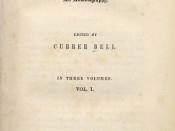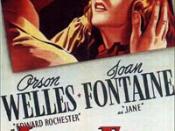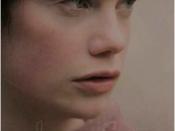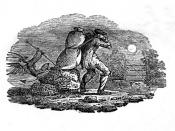'Jane Eyre' is a semi-autobiographical novel first published in October 1847 by Charlotte Bronte under the pseudonym of Currer Bell. Bronte had to use this name because, at the time, women were seen as inferior and her novel would not have been taken seriously. 'Jane Eyre' is a love story with a happy ending. It is surprising that the reader sympathizes for Jane as, at the time of the Victorian era, it was frowned upon for a woman to love a married man. Jane is not portrayed as a normal heroine thus making her character different from others in diverse novels of the Victorian period. 'Jane Eyre', is written in the first person, narrative form. This adds interest to the reader because the novel is therefore presented with a more mature approach and has the benefit of hindsight. Pathetic fallacy is also used a lot throughout and Bronte uses this to reflect Jane's moods and also to represent Jane's life as a whole.
Pathetic fallacy is instantly introduced into the novel within the first paragraph. Bronte helps the reader picture the scene with words such as, 'clouds so sombre', and 'a rain so penetrating' leaving an image of bleakness. This also shows Jane's mood towards the walks that she had luckily been able to avoid taking on the day the novel begins clearly showing her dislike. Another reason for Jane not wishing to take walks, other than the physical dislike towards the cold that the walk would bring, is that she is saddened by receiving 'chidings' from Bessie her nurse and is 'humbled' by her 'physical inferiority' to her cousins.
Separation of both physical and mental kinds are shown through chapter one beginning as soon as you open the book as the reader notices that Jane Eyre doesn't share the same surname as the rest of the characters being introduced into this chapter, therefore showing us that she is an outsider. Bronte uses dialogue to show the coldness that Mrs. Reed shows towards Jane and this gains pity from the reader on Jane's behalf. The way that Jane has simply been separated away from her cousins who are 'clustered round their mamma' by her aunt fills the reader with sympathy because Jane is set apart with no explanation nor reason for why, and is scorned for trying to ask for the reasons.
Jane leaves her aunt and cousins and goes into the breakfast-room where she takes a book entitled 'History of British Birds' by Bewick. Extracts that Jane mentions are relevant to her situation such as, 'solitary rocks', 'bleak shores' and 'forlorn regions' all showing Jane's loneliness. Bronte then goes on to show some of Jane's descriptive mind by Jane speaking of the pictures in the introductory pages of her book. To read the book, Jane had moved to a window seat and concealed herself behind a red curtain where she was 'shrined in double retirement'. Bronte uses colour imagery through the book mainly focusing on red to show many things including passion, love, hatred, fear and in this case, safety. It is as if Jane is in a womb-like environment keeping her safe from the coldness surrounding her. On one side is the coldness of her aunt and cousins and on the other side of her, through the window, is the bitter cold of the outdoors. Jane is finally happy with her book and her solitude showing that she is easily pleased but rarely gets the ability to actually be happy. The reader is, for the first time, glad for Jane that she has finally found some happiness - but that is short-lived.
The description that Bronte gives us, the reader, of John Reed describes him as an unattractive, gross, spoilt and generally horrible young boy. The reader is not meant to like John Reed. John represents the repressive authority of Victorian males and helps illustrate the position of men in the social circles of this era. Jane is very much scared of John as he bullied and punished her 'not two or three times in the week, nor once or twice in a day, but continually'. Bronte also states how 'every morsel of flesh on my [Jane's} bones shrank when he came near' which gains huge amounts of sympathy and even anger at the way she is treated like this but no one cares to reprimand John. He is constantly sneering at Jane and abuses the authority he has gained for being born male. After bullying Jane with how she shouldn't be allowed in his' household and saying how Jane was a 'dependant', John strikes her and then throws the book at her head; at this point Jane fights back. Although in those times, it was against the normal ways for a woman to speak against a man, Jane retaliates and uses her knowledge gained from her book reading to insult John. She is very dramatic when she does this and compares herself to a slave and John a slave driver. Jane then goes one step further, shocking the reader, and attacks John in fury. When help comes, Jane is instantly blamed although it is clear not to be her fault, which, once again, brings up a feeling of anger and the unfair treatment Jane receives in this situation. When Mrs. Reed sends Jane to 'the red room' the reader is left at the end f the chapter not knowing why this sounds so foreboding and wanting to read on.
In conclusion, I believe that Charlotte Bronte is extremely successful in engaging the reader's interest and establishing the concerns of the novel in the first chapter. The reader becomes interested in the novel through Bronte's use of dialogue, first person narrative, use of language, character relations and pathetic fallacy. The concerns of the novel are clearly set out for the rest of the novel showing that the book will be about the life of Jane Eyre, a misfit of the Victorian era through her passionate and active personality. The reader is left eager to find out what will be to come after the closing paragraph of chapter one, will the poor and young Jane Eyre grow to find a happier life of will her misery persist?





